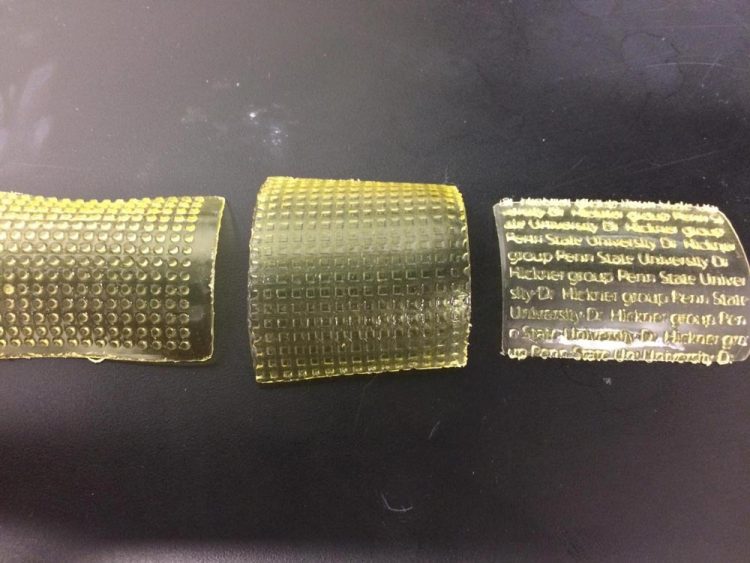3-D printing of patterned membranes opens door to rapid advances in membrane technology

Patterned membranes were created by 3-D printing. Credit: Hickner Group/Penn State
Ion exchange membranes are used in many types of energy applications, such as fuel cells and certain batteries, as well as in water purification, desalination, removal of heavy metals and food processing. Most of these membranes are thin, flat sheets similar to the plastic wrap in your kitchen drawer.
However, recent work has shown that by creating 3-D patterns on top of the 2-D membrane surface, interesting hydrodynamic properties emerge that can improve ion transport or mitigate fouling, a serious problem in many membrane applications.
Currently, making these patterned membranes, also called profiled membranes, involves a laborious process of etching a silicon mold with the desired pattern, pouring in the polymer and waiting until it hardens. The process is both time-consuming and expensive, and results in a single pattern type.
“We thought if we could use 3-D printing to fabricate our custom-synthesized ion exchange membranes, we could make any sort of pattern and we could make it quickly,” says Michael Hickner, associate professor of materials science and engineering, Penn State.
In a paper published online today in the American Chemical Society's journal ACS Applied Materials and Interfaces, Hickner's team describes the development of a custom 3-D photolithographic printing process similar in concept to a current 3-D process called stereolithography.
The team developed a photocurable mixture of ionic polymers and exposed the mixture under a light projector to harden the base layer. They then added more polymer to the base layer and projected a pattern on the new material to selectively harden the surface. The surface pattern increases the conductivity of the membrane by as much as a factor of two or three.
“Membranes act like a resistor in a battery or fuel cell,” says Hickner, who is also a member of the Materials Research Institute. “If you can lower the resistance by a factor of two or three, you've really got something useful.”
The paper's lead author, Jiho Seo, a Ph.D. candidate in materials science and engineering , added, “While surface-patterned membranes have been studied previously, this is the first 3-D printed example of these structures and the first model that really explains the resistance decrease in a quantitative way.
A simple parallel resistance model describes the effect of the pattern on lowering the resistance of these new membranes. This insight gives us a design tool to continue to innovate and create new patterns for further improvements along with changing the intrinsic chemistry of the material.”
The team will continue to optimize the geometry and chemistry of the membranes they print, as well as learn to print new materials, both for membranes and beyond, that have never been printed heretofore.
“We want to bridge the fundamental chemistry and materials science that we do with the engineering and rapid design iterations that the 3-D printing industry is really good at,” Hickner concludes.
###
In addition to Seo and Hickner, Douglas Kushner, Ph.D. student in materials science and engineering, contributed to the paper, titled “3-D Printing of Micro-patterned Anion Exchange Membranes.”
Support for the photolithography system was provided by Penn State Department of Materials Science and Engineering. The Materials Research Institute and the Penn State Institutes of Energy and the Environment provided infrastructure support.
Media Contact
All latest news from the category: Materials Sciences
Materials management deals with the research, development, manufacturing and processing of raw and industrial materials. Key aspects here are biological and medical issues, which play an increasingly important role in this field.
innovations-report offers in-depth articles related to the development and application of materials and the structure and properties of new materials.
Newest articles

High-energy-density aqueous battery based on halogen multi-electron transfer
Traditional non-aqueous lithium-ion batteries have a high energy density, but their safety is compromised due to the flammable organic electrolytes they utilize. Aqueous batteries use water as the solvent for…

First-ever combined heart pump and pig kidney transplant
…gives new hope to patient with terminal illness. Surgeons at NYU Langone Health performed the first-ever combined mechanical heart pump and gene-edited pig kidney transplant surgery in a 54-year-old woman…

Biophysics: Testing how well biomarkers work
LMU researchers have developed a method to determine how reliably target proteins can be labeled using super-resolution fluorescence microscopy. Modern microscopy techniques make it possible to examine the inner workings…





















